Grave marker
This gallery gives an overview of grave markers and related sub-categories. For each, there is a description here and and at least one example reference picture.
This page is meant to help users categorizing images of graves. The categorization scheme 'Grave markers' is part of the Commons: Category scheme memorials, and gives documentation for Category: Grave markers and its sub-categories.
A grave marker is any permanent monument which marks a grave for the dead. The vast majority are external. The most common internal marker is the Christian church monument for which see below.
object marking the position of a burial place | |||||
| Upload media | |||||
| Subclass of | |||||
|---|---|---|---|---|---|
| |||||
Gravestones are the most common form of grave marker: Upright (also called a Headstone) or flat slabs of inscribed stone.
| Simple headstone | Elaborate headstone | Double headstone | Cuboid gravestone | Flat graveslab |
|---|---|---|---|---|

|

|
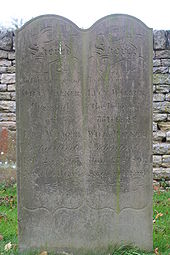
|

|

|
Other shapes
[edit]Columns or broken columns, the symbol of a life cut-short.
| Full-height column | Broken column |
|---|---|
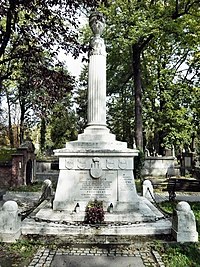
|

|
The most popular of Christian motifs.
| Simple cross | Elaborate cross | Celtic cross |
|---|---|---|

|

|

|
Tall, narrow, usually four-sided, tapering monuments ending in a small pyramidal top, some in imitation of Egyptian obelisks.
| Simple obelisk | Stumpy obelisk | Elaborate obelisk |
|---|---|---|
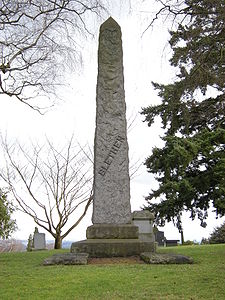
|

|

|
The Star of David is the most popular of Jewish symbols.
| Grave star |
|---|

|
Tomb-style chests, sometimes called table tombs or altar tombs. They are monuments, not tombs, as the body is beneath the chest rather than within it.
| Simple tomb chest | Elaborate tomb chest |
|---|---|

|

|
A variety of sculptures, usually in stone: Statues, effigies, busts and reliefs.
| Angel sculpture | Religious sculpture | Secular sculpture | Grave statue | Grave bust | Grave relief |
|---|---|---|---|---|---|

|

|

|

|

|

|
A variety of sculptures in bronze: Statues, effigies, busts and reliefs. These are not necessarily solid bronze. Particularly in Germany and surrounding areas, they may be plaster electroplated with bronze, generally called 'Galvanoplastik'.
| Angel sculpture | Religious sculpture | Grave statue | Grave bust | Grave relief |
|---|---|---|---|---|
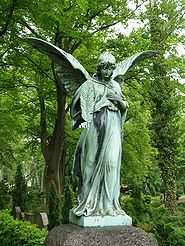
|

|

|

|

|
Church monuments are architectural or sculptural memorials to dead persons within a Christian place of worship or funerary building. They come in many shapes and forms. Wall mounted versions and those with effigies are probably the best known. The grave is usually beneath the monument or nearby, or occasionally within it. However, they can also be cenotaphs. For details, see the Church monuments gallery.
| See Church monuments |
|---|

|
Architectural or sculptural memorials to dead persons within an Islamic funerary building.
| Islamic monument |
|---|

|
Regionally specific grave markers
[edit]Japanese stone lanterns.
| Grave lantern |
|---|

|
The 'five-ringed tower' Japanese grave columns.
| Gorintō |
|---|
A grave orb is a Scandinavian petrosphere used in the Nordic Iron Age.
| Grave orb |
|---|
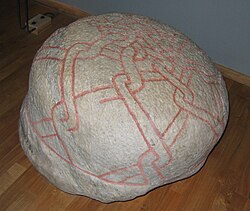
|
A Hungarian funerary sculpture. In origin, it was a jousting lance stuck in the ground as a grave monument.
| Kopjafa |
|---|
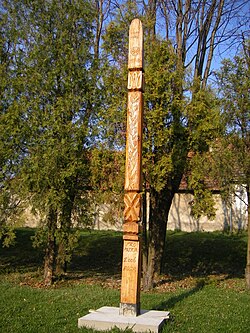
|
Other materials
[edit]Grave markers made of wood.
| Wooden grave marker |
|---|

|
Grave markers made of iron. Often made by the local blacksmith.
| Iron grave marker |
|---|
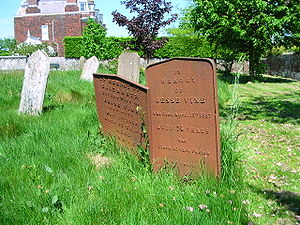
|
Grave markers made of bronze, including the sculpure sub-category above.
| Bronze grave marker |
|---|

|
The main categorization scheme is repeated wholly or partially with its country qualification beneath Grave markers by country categories, such as Grave markers in Germany.
Some graves can be categorized by the rank or occupation of the person or people within the grave, such as Gravestones to people by occupation.
